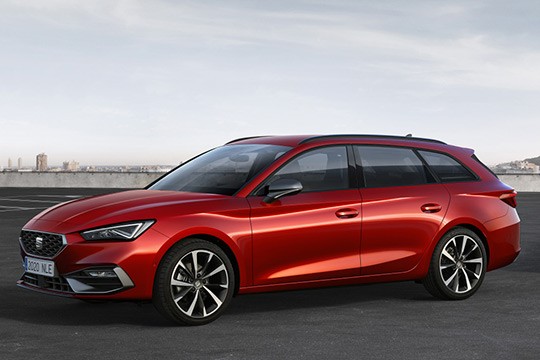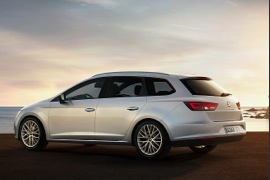SEAT Leon ST Estate Models/Series Timeline, Specifications & Photos
First production year: 2013
Engines: Mild hybrid, Gasoline, Hybrid, Natural gas, Diesel
Body style: Wagon (station wagon, estate, combi, touring)
In 2020, right before the world pandemic situation, SEAT was forced to find a solution to launch its well-known lineup Leon, and it found it: it unveiled the car at its Martorell factory in Spain. Along with the fourth generation of the compact hatchback, it also revealed the second generation of the station wagon version of it, named Sportstourer.
SEAT unveiled both the hatchback and the station wagon at its factory at Martorell in late January 2020, before lockdown. After that, the industry stopped, and the cars had to wait better days to be received by their customers. Fortunately, those days came later that year, and the Sportstourer, together with its hatchback sibling, finally enjoyed the smooth tarmac of Spain and other European countries.
Both versions were built on the same MQB Evo platform shared with the Volkswagen Golf and Skoda Octavia, but unlike its siblings, it featured a more emotional design, typical for the Spanish brand.
At the front, the 2020 Leon Sportstourer featured an angular design with a shield-like grille adorned by a chicken-wire pattern design and surrounded by a gray-satin rim. Its LED headlights incorporated triangular-shaped daytime running lights, and the headlamps featured a narrower inner area than on their outer side. The lower bumper sported a lower grille flanked by fake air scoops that sported the optional LED fog lamps.
Unlike its hatchback sibling, the Sportstourer featured a roof line extended behind the rear seats over the longer rear overhang than the regular Leon. Still, to keep the “sports” spirit, the vehicle featured a raked forward tailgate adorned by a roof spoiler.
Inside, the automaker offered standard bucket seats at the front separated by a tall center console that housed the gear stick (or the gear selector for the automatic transmission versions) and a storage compartment under the center armrest. On the center stack, the automaker offered an 8.25” touchscreen for the standard unit system, while a 10” one was available as an option.
The system was carried over from the Golf and didn’t have a turning knob for the volume or regular controls for the HVAC system. Everything was with touch buttons and sliders. Fronting the driver was a 10.25” digital display that replaced the dials inside the instrument cluster, and there, the driver could choose what to see. In the back, the split-folding bench seat could accommodate two passengers comfortably due to the tall center tunnel that crossed the car from front to back. Behind them, the Sportstourer offered a generous 617 liter (21.8 cu-ft) luggage compartment.
Under the hood, the automaker installed a choice of gasoline or diesel engines, which sent their power to the front wheels only via five or six-speed manuals or six or seven-speed automatics (dual clutch).
The Spanish brand owned by Volkswagen shared its platform with the Golf or the Audi A3. Unlike its more famous siblings, it didn’t have access to the same markets as these two. Still, the design language of this brand was its most powerful weapon since, from the mechanical point of view, it was similar to them. While the five-door hatchback Leon targeted young customers and regular families, the station wagon, called ST in SEAT’s naming system, aimed at those who needed larger trunks for bikes, kites, or other larger items.
It was the first generation of the Leon to receive a station wagon version. The previous two generations were offered just as five-door hatchbacks and the Spanish automaker tried to experiment with this segment as well. By 2013, the car market shifted and didn’t want minivans anymore, so the station wagon could’ve been an appropriate alternative. As a result, SEAT took the gamble and made the ST based on the Leon hatchback. The new version shared the first half, up to the B-pillars, with its hatchback sibling. It even kept the same door panels both front and rear but had a different roof and a third set of windows mounted between the C-pillars and the raked-forward D-pillars. Thanks to the longer roof, the automaker could install a panoramic glass on it. The rear overhang was longer, but its size was neatly concealed thanks to a redesigned bumper.
While most station wagons on the market were offered with dull interiors and comfy seats only, SEAT took a different approach. The base models were fitted with similar front seats as the rest of its competitors, but the automaker also offered an option for high-bolstered ones for those who still enjoyed a spirited drive on a winding road, regardless of the vehicle’s station-wagon shape. Moreover, the rear bench seat was profiled for two with sculptured side bolsters. Fronting the driver was the e two-dial instrument cluster offered in the regular Leon, and the automaker offered the option for an LCD between the speedometer and tachometer that showed not just information about the car from the vehicle’s onboard computer but also from the navigation system. The advantage of a station wagon was the split-folding rear bench seat. With the rear seats up, the Leon ST offered 587 liters (20.7 cu-ft) of space, and with those folded flat, it reached 1,470 liters (52 cu-ft.).
Since the car was just 45 kilos (100 lbs.) heavier than its hatchback sibling, it offered similar performance. Moreover, the automaker installed a wide choice of engines in it, ranging between 115 PS and 184 PS (113 HP – 181 HP). Strangely, the most potent version was a 2.0-liter turbo-diesel, not a spark-ignited powerplant. Unlike the Golf Variant, the Leon ST was available with a front-wheel-drive system only.
SEAT Leon ST Estate 1.0L EcoTSI 5MT FWD (115 HP)
SEAT Leon ST Estate 1.0L EcoTSI 5MT FWD (115 HP)
SEAT Leon ST Estate 1.2L TSI 5MT FWD (86 HP)
SEAT Leon ST Estate 1.2L TSI 6MT FWD (105 HP)
SEAT Leon ST Estate 1.2L TSI 6MT FWD (110 HP)
SEAT Leon ST Estate 1.2L TSI 7AT FWD (105 HP)
SEAT Leon ST Estate 1.2L TSI 7AT FWD (110 HP)
SEAT Leon ST Estate 1.4L TSI 6MT FWD (125 HP)
SEAT Leon ST Estate 1.4L TSI 6MT FWD (140 HP)
SEAT Leon ST Estate 1.4L TSI 6MT FWD (150 HP)
SEAT Leon ST Estate 1.6L TDI 5MT FWD (105 HP)
SEAT Leon ST Estate 1.6L TDI 5MT FWD (90 HP)
SEAT Leon ST Estate 1.6L TDI 6MT FWD (110 HP)
SEAT Leon ST Estate 1.6L TDI 7AT FWD (105 HP)
SEAT Leon ST Estate 2.0L TDI 6MT FWD (150 HP)
SEAT Leon ST Estate 2.0L TDI 6MT FWD (184 HP)

